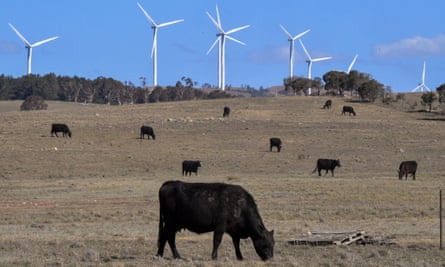Extract from The Guardian
The new ‘climate league’ is calling on insurers, banks and companies to sign up to a goal of reducing national emissions by about 45% by 2030

Last modified on Wed 14 Oct 2020 04.23 AEDT
Major investors and super funds will lead a push for the private sector to make much deeper cuts in national greenhouse gas emissions by 2030 than planned by the Morrison government, including setting a target based on what scientists say is necessary.
The newly created “climate league 2030” is calling on investors, insurers, banks and companies to sign up to a goal of reducing national emissions by at least 230m tonnes a year more than the government forecasts by 2030.
It is equivalent to about a 45% cut by 2030 compared with the 2005 benchmark used by the government – the minimum short-term target recommended by the government’s Climate Change Authority for Australia to play its part in keeping average global heating below 2C. They say action is needed now to put the country on a path to net zero emissions by 2050.
The league’s foundation members are 16 institutional investors that collectively manage assets worth more than $850bn. They include Aware Super, Cbus, IFM Investors, the Queensland Investment Corporation, AustralianSuper, Hesta, Lendlease Funds Management and UniSuper.
Aware Super’s chief executive, Deanne Stewart, said it was critical that businesses, investors and governments set and delivered transparent, meaningful and measurable targets and goals “to really shift the dial and achieve lasting action” to halt the potentially devastating impacts of the climate crisis.
“We can do this individually, but collaboratively we have the power to do so much more,” she said. “As a founding member of climate league 2030 we would encourage other investors, businesses and the community to come together, stop talking about the issues and instead start taking meaningful action to support a necessary transition to a low carbon and sustainable economy.”
The aspirational initiative is coordinated by the Investor Group on Climate Change, which based the idea on similar projects overseas, such as We Are Still In and We Mean Business in the US and the Climate Leaders Coalition in New Zealand.
Members are responsible for their own actions, but are expected to demonstrate that they can and will lead to a reduction in national emissions. The group said the league would be open to other parts of the private sector in coming months and promised a progress report late next year.
The league has the support of Mark Carney, the former Bank of England governor now working as a UN special envoy for climate action and finance. He said the $3.5tn Australian super industry was the world’s fifth largest, giving it significant influence and investors were increasingly recognising that “climate risk is investment risk”.
“Achieving net zero emissions by 2050 will require a whole of economy transition and every company, bank, insurer and investor will be part of that,” Carney said in a statement. “The investment and innovation necessary for this shift will also create the greatest commercial opportunity of our time and support a post-Covid green recovery.”
Stephen Dunne, the investor group’s chair and a Cbus director, said institutional investors held an “important stewardship role” in the economy. “That puts us in a unique position to help facilitate an orderly transition to net zero emissions that is aligned with the goals of the Paris agreement,” he said.
Signatories to the Paris agreement, including Australia, commissioned a report from the Intergovernmental Panel on Climate Change that found global emissions would need to be about 45% below 2010 levels by 2030 and net zero by mid-century to limit global heating to about 1.5C – a goal they agreed to pursue.
But the Morrison government has rejected calls from business, farming, energy, industry and environment groups that it set a net zero target for 2050, saying instead the country would reach that target in the “second half of the century”.
More than 100 countries have net zero targets for the middle of the century. China, the world’s biggest annual emitter and the country responsible for most of the increase in global emissions in 2019, last month promised it would reach “carbon neutrality” before 2060.
While the pledge by the Chinese president, Xi Jinping, left unanswered questions, it prompted analysts to warn Australia risked being left behind in the “inevitable transition” to net zero emissions. It was followed by the European parliament last week supporting a goal for the continent of a 60% cut below 1990 levels by 2030. The Morrison government’s 2030 target is a minimum 26% cut below 2005 levels.
An analysis published earlier this week by the Investor Group on Climate Change suggested the Morrison government could trigger an investment boom in renewable energy, manufacturing, carbon sequestration and clean transport worth $63bn over the next five years if it set a net zero emissions target for 2050.
No comments:
Post a Comment